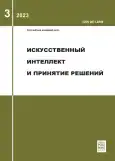On Properties of Risk Indicators in Comparing Interval Alternatives Problems
- Autores: Shepelev G.I.1
-
Afiliações:
- Federal Research Center “Computer Science and Control”, RAS
- Edição: Nº 3 (2023)
- Páginas: 70-75
- Seção: Optimal and Rational Choice
- URL: https://journal-vniispk.ru/2071-8594/article/view/270343
- DOI: https://doi.org/10.14357/20718594230307
- ID: 270343
Citar
Texto integral
Resumo
The correspondence of some risk indicators to the requirement of their coordinated change with the associated preference indicators is studied for problems of comparing interval alternatives. A coordinated change is such a change, in which the value of the corresponding risk indicator increases with the growth of the preference indicator. It is shown that in methods of individual risk, the “mean-risk” type, left-sided risk indicators are coordinated for choosing the distribution mode as an indicator of preference, and also, with known limitations, for choosing the distribution median as a measure of preference. It has been established that the indicator of the mean semi-deviation, which is recommended as an indicator of risk for choosing the mathematical expectation of the distribution as a measure of preference, does not meet this requirement, and therefore cannot, generally speaking, be considered as adequate for problems of comparing interval alternatives.
Texto integral
Sobre autores
Gennady Shepelev
Federal Research Center “Computer Science and Control”, RAS
Autor responsável pela correspondência
Email: gis@isa.ru
Candidate of physical and mathematical sciences, senior researcher. Leading Researcher
Rússia, MoscowBibliografia
- Kantorovich L.V. O nekotorykh novykh podkhodakh k vychislitelnym metodam i obrabotke nablyudeny [On some new approaches to computational methods and processing of observations] // Sibirski matematichesky zhurnal [Siberian Mathematical Journal]. 1962. V. 3. No 5. P. 701–709.
- Wilensky P., Livshitz V., Smolyak S. Otsenka effectivnosti investitsionnykh proektov. Teoriya i praktika [Evaluation of the effectiveness of investment projects. Theory and practice] Moscow: Polyprint Serice. 2015.
- Fishburn P.C. Mean-risk analysis with risk associated with below-target returns // American Economic Review. 1977. V. 67. P. 116–126.
- Sortino F.A., Meer R.V. Downside Risk // Journal of Portfolio Management. 1991. V. 17. No 4. P. 27–31.
- Smolyak S. A. O sravnenii alternative so slushainym effektom [On comparing alternatives with a random effect]// Ekonomika i matematicheskie metody [Economics and mathematical methods]. 1996. V. 32. Issue 4. P. 107 – 123.
- Ogryczak W, Ruszczyński A. From stochastic dominance to mean-risk models: semideviations as risk measures // European journal of operational research. 1999. V. 116. P. 33–50.
- Nawrocki D. A Brief History of Downside Risk Measures//The Journal of Investing. 1999. V. 8. No 3. P. 9–25.
- Szegö G. Measures of risk // J. Banking&Finance. 2002. V. 26. No 7. P. 1253–1272.
- Sternin M., Shepelev G. Obobshchennye intervalnye ekspertnye otsenki v prinyatii resheny [Generalized interval expert estimations in decision-making] // Doklady Аkademii nauk [Proceedings of the Аcademy of sciences] 2010. V. 432. No 1. P. 33–34.
- Grechuk B., Molyboha A., Zabarankin M. Mean-deviation analysis in the theory of choice // Risk analysis. 2012. V. 32. P. 1277–1292.
- Podinovsky V. Chislovye mery riska kak kriterii vybora pri verotnostnoi neopredelennosti [Numerical measures of risk as choice criteria under probabilistic uncertainty] // Artificial Intelligence and Decision Making]. 2015. No 2. P. 60–74.
- Shepelev G., Khairova N. Collective risk estimating method for comparing poly-interval objects in intelligent systems // COLINS-2021: 5th International Conference on Computational Linguistics and Intelligent Systems. CEUR Workshop Proceedings. 2021. Vol. 1-2870. P. 866-876.
Arquivos suplementares








